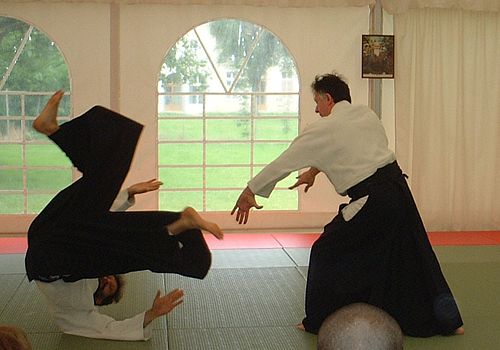Aiki (合気, "joining spirit"), a Japanesebudō term, at its most basic is a principle that allows a conditioned practitioner to negate or redirect an opponent's power. When applied, theaiki practitioner controls the actions of the attacker with minimal effort and with a distinct absence of muscular tension usually associated with physical effort.
InJapaneseAiki is formed from twokanji:
The kanji forai is made of three radicals, "join", "one" and "mouth". Hence,ai symbolizes things coming together, merging.Aiki should not be confused withwa which refers to harmony. The kanji forki represents a pot filled with steaming rice and a lid on it. Hence,ki symbolizes energy (in the body).
Thusaiki's meaning is to fit, join, or combine energy. However, care must be taken about the absolute meanings of words when discussing concepts derived from other cultures and expressed in different languages. This is particularly true when the words we use today have been derived from symbols, in this case, Japanese kanji, which represent ideas rather than literal translations of the components. Historical use of a term can influence meanings and be passed down by those wishing to illustrate ideas with the best word or phrase available to them. In this way, there may be a divergence of the meaning between arts or schools within the same art. The charactersai andki have translations to many different English words.
Historically, the principle ofaiki would be primarily transmitted orally, as such teachings were often a closely guarded secret. In modern times, the description of the concept varies from the physical[1] to vague and open-ended, or more concerned with spiritual aspects.

Aiki lends its name to various Japanese martial arts, most notablyAikido,[2] and its parent art,Daito-ryu aiki-jujutsu. These arts tend to use the principle ofaiki as a core element underpinning the bulk of their techniques.Aiki is an important principle in several other arts such asKito-ryu,Judo,Yamabujin Goshin jutsu and various forms ofKenjutsu and JapaneseJujutsu.[3] Techniques accomplished withaiki are subtle and require little mechanical force with theaiki arts generally classed assoft internal martial arts.
Aiki is a complex concept, and three aspects have been used to describe it in relation to a martial situation:
1)Blending, not clashing
2)Leading the assailant
3)Use of internal strength – Ki energy
Aiki is considered to be an ancient practice, and its practice is often kept within a particular individual or two from a family/school lineage. Culturally, and due to certain necessities of the time period, theaiki knowledge was usually a very well-guarded secret and rarely disclosed.
The oldest book to have historically discussedaiki was the 1899Budo Hiketsu-Aiki no Jutsu. On the subject ofaiki it was written:
The most profound and mysterious art in the world is the art of aiki. This is the secret principle of all the martial arts in Japan. One who masters it can be an unparalleled martial genius.[7]
TheTextbook of Jujutsu (Jujutsu Kyoju-sho Ryu no Maki) from 1913 stated:
Aiki is an impassive state of mind without a blind side, slackness, evil intention, or fear. There is no difference between aiki and ki-ai; however, if compared, when expressed dynamically aiki is called kiai, and when expressed statically, it is aiki.[7]
The termaiki has been used since ancient times and is not unique toDaito-ryu. Theki inaiki isgo no sen, meaning to respond to an attack.
... Daito-ryu is all go no sen—you first evade your opponent's attack and then strike or control him. Likewise,Itto-ryu is primarily go no sen. You attack because an opponent attacks you. This implies not cutting your opponent. This is called katsujinken (life-giving sword). Its opposite is called setsuninken (death-dealing sword).[8]